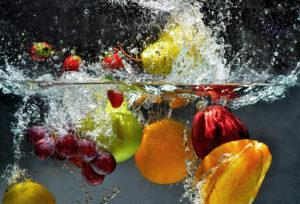How and with what to wash vegetables and fruits so as not to get sick?
 Even children know that fruits and vegetables should always be washed before meals to remove dirt, microbes and chemical residues that have been used to treat plants as they grow. And so that a vegetable salad or fruit dessert does not become a “springboard” to the hospital, the approach to food processing should be individual.
Even children know that fruits and vegetables should always be washed before meals to remove dirt, microbes and chemical residues that have been used to treat plants as they grow. And so that a vegetable salad or fruit dessert does not become a “springboard” to the hospital, the approach to food processing should be individual.
The content of the article:
General rules for washing vegetables and fruits
Rinsing under running water is usually sufficient to remove dirt and dust from vegetables and fruits.
But if the product also contains harmful microorganisms, pesticides, traces of processing for storage (wax and paraffin) or even “thermonuclear” chemistry used to protect plants, plain water is indispensable. Heavier artillery is needed here.
Video: How to properly wash fruits and vegetables?
First of all, let’s talk about the general rules for processing purchased (plucked, dug out) vegetables and fruits:
- If you are sure of the purity of vegetables and fruits, since you brought them from your own garden, then you can get by with running water. For purchased ones (especially imported ones), the rules are different. First of all, we get rid of waxes and paraffin. To do this, wash fruits and vegetables in water with a separate brush, and then rinse them under the tap.
- If fruits and vegetables are bought for kids, first we soak the future salad or dessert in cold water (at the same time we will get rid of the share of harmful substances inside the fruit, if any), and then rinse it in the usual way and cut off the skin. Of course, for homemade apples this “trick” will be superfluous, but for imported glossy apples it is highly recommended.
- If you washed fruits and vegetables, then eat them immediately or use them on jams, salads, etc.… Do not store them for long after washing. Firstly, they quickly deteriorate, and secondly, they lose vitamins and other useful substances.
- Only use stainless steel appliances for cleaning.
- If you have yellow spots on vegetables (zucchini, cucumbers or potatoes), get rid of them immediately and without hesitation. Such spots are a sign of excess nitrates. You can reduce the level of nitrates by soaking potatoes or carrots in salted water for a day. But along with nitrates, you will also get rid of vitamins.
- Fruits and vegetables prepared for toddlers, it is recommended to wash not with running, but with distilled water.
- It is strictly forbidden to use dish detergent or ordinary soap for fruits and vegetables. Chemical components can get under the skin of the fruit and cause poisoning.
Means for washing vegetables and fruits – shop and home
Whoever advises you to use laundry soap – or any dishwashing detergent – for processing fruits and vegetables, confirming the effectiveness of the classic “well, you see – nothing happened to me” – do not listen! A categorical prohibition on these products when washing fruits! They are not rinsed out to the end (even if it is a children’s “ECO-remedy”), and the components of the remedy are sent along with fruits and vegetables straight to your body.
What means to use if “just rinse” did not work?

Home remedies:
- Baby soap no additives, colors or flavors.
- Lemon juice + soda. For the “cleaning agent”, mix a spoonful of baking soda and a spoonful of lemon juice in a glass of water. Next, pour the solution into a clean spray bottle, sprinkle on the fruits, wait 2-3 minutes and rinse in the usual way. After use, hide the product in the refrigerator.
- Vinegar. We take the product in half with ordinary water, stir, wash the fruits in the solution and rinse them under the tap. It will help in removing wax and disinfecting.
- Salt. For 1 liter of water – 4 tbsp / l of common salt.
- Hydrogen peroxide. With its help, you will not only cleanse the fruit, but also disinfect it. The tool is used simply: in a container with water – 1 tbsp / l of the drug.
Professional tools:
Yes, yes, there are such. It’s just that they have not yet firmly established themselves on the domestic market.
The scheme of application is simple and does not require unnecessary actions with soda, peroxide, etc.
So, the best are recognized …
- Bentley Organic. This composition contains natural acids (approx. – malic, lactic and citric), as well as aloe vera. High efficiency against bacteria and microbes – 100% neutralization of all “infection”.
- Safeguard Fruit Veggie Wash. This “set” of components: plant extracts and glycerin, emulsifiers, aloe vera, and citrus essential oils. Cleansing is 100 times more effective than ordinary water.
- Mako Clean. Similar in composition to the 1st product, but less expensive. Our, domestic product with high efficiency and absolute safety.
- Eat Cleaner. Ideal for those who like to have a snack with vegetables / fruits in nature. It is a napkin with a special impregnation: vegetable glycerin, natural (natural) detergents, sea salt, citric acid and sodium citrate. The very case when you can do without washing the fruit (just wipe it with a napkin).
- Sodasan. Special liquid “soap” for fruits and vegetables. It is applied to the fruit and then washed off abundantly with water. Contains: saponified vegetable oils, classic soda, fruit acids and grapefruit extract. Recommended for melons and watermelons.
Of course, these funds are more expensive than we would like, but their consumption is very insignificant, and one bottle of funds is usually enough for a very long period.

How to wash various vegetables – instructions for the hostess
Each vegetable has its own processing method!
For instance…
- White cabbage. As a rule, it is not even washed. 2-3 layers of leaves are simply removed from it (to clean and fresh), and then a stump is cut out. It was 20-25 years ago that children considered cabbage stumps a delicacy and waited for their mother to start “cutting” the cabbage. Today the stump is an unambiguous source of nitrates (it is in it that they are collected).
- Cauliflower. On this vegetable, we clean all the darkened areas with a knife (or a vegetable grater), and then disassemble it into inflorescences and lower it in salted water for 10 minutes so that all the worms that adore cauliflower flare up to the surface.
- Kohlrabi rinse and free from its skin.
- Artichokes. First, the stem is cut off from these vegetables, then all damaged leaves are removed, and only after that they are washed in running water, setting aside baskets and bases of artichoke leaves for cooking (approx. – do not eat the rest).
- Roots (approx. – horseradish and radishes, carrots and potatoes, beets, etc.) first soak in warm water and then brush off the ground with a brush. Next, we rinse in warm and then in cold water, and then remove the peel.
- By the corn first remove the leaves, and then rinse under the tap.
- Cucumbers and tomatoes (as well as leguminous vegetables, eggplants, peppers and squash) soak for a short time in cold water (if there is a suspicion of nitrates, it can be in salted water), then rinse under the tap.
- Asparagus it is usually peeled in a wide bowl and with a sharp knife, starting from the head of the vegetable and along its base. Immediately after cleaning, rinse thoroughly under the tap.

Proper washing of fruits and berries
Even if you personally plucked fruits from trees, this does not mean that you can eat them just by rubbing them on your shirt.
The approach to fruits is no less special than to vegetables.
- Citrus. They are usually sold shiny from wax and other substances. And even after washing, they remain a little sticky. Therefore, first you should scald the lemon (orange, etc.) with boiling water from the kettle, and then rinse it under the tap.
- As for the pineapples, they are washed together with the leaves under the tap – with cold water. Then let it dry on its own.
- Melons and watermelons, pumpkins and zucchini my special or home remedy in the bathroom (or sink) with a brush.
- Pomegranates, pears with apples, apricots with peaches and plums briefly soak in cold water and rinse with the usual method under the tap.
- Grape it is recommended to put it under a tap shower in a bowl or colander and, dividing into bunches, rinse.
- For dried fruits soaking is necessary. But first – a shower with boiling water.
- Berries, like grapes, put in a colander in 1 layer (do not heap it in a big heap!) and leave it under the “shower” for 4-5 minutes. If there are doubts about the purity of the berries (for example, strawberries with soil on the skin or too sticky cherries), then we dip the colander with them into hot water, then into very cold water, then again into hot and again into cold water. This will be enough.

How to wash herbs – parsley, green onions, dill, etc.?
According to parasitologists, any greenery can be dangerous. Including the one that is grown with caring own hands in the garden bed.
Poorly washed greens are practically “Russian roulette”. Maybe lucky, maybe not.
Video: How to properly wash greens? Part 1
Video: How to properly wash greens? Part 2
To stay alive and well, remember the rules for washing greens:
- We remove the roots, the lower part of the stems (approx. – nitrates settle in them) and rotten parts.
- Thoroughly wash off any visible dirt under the tap.
- Now we soak greens in salt water. (for 1 liter – 1 tablespoon of salt) for 15 minutes. All dirt will settle on the bottom of the dish.
- Further, do not drain the water (!), and carefully take out the greens and transfer them to a colander. Then we rinse again (thoroughly!) And only then cut into a salad.
What else do you need to remember?
- The main danger is hiding between leaves and in areas where the stem and branches meet (for example, helminth eggs or remnants of soil with fertilizers).
- Lettuce celery can be soaked in cold water for an hour and a half and then rinsed.
- First, put the nettle in boiling water for 2-3 minutes, and then cool it under running water.
- We wash the green salad especially thoroughly (according to statistics, they are “poisoned” most often). It is recommended to separate each sheet, tear off a part of its base and then rinse it especially thoroughly from 2 sides until the feeling of “slipperiness” disappears – that is, until it squeaks.
If you liked our article and you have any thoughts about this, please share with us. Your opinion is very important for us!
What to give a friend?
Gift Certificate! You can give it to your loved one or use it yourself.
And we also give away a certificate for 3000 rubles every month. among new email subscribers. Subscribe!
Select a certificate in the store
Visit Bologny for more useful and informative articles!





